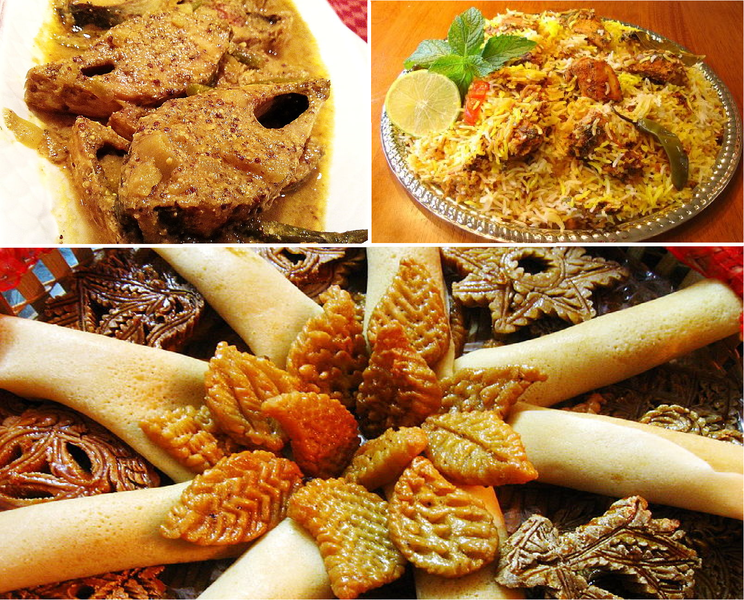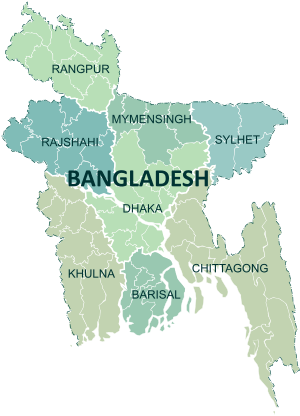Bangladesh
Bangladesh, officially the People's
Republic of Bangladesh is a country in South Asia. It is the world's 8th-most
populous country. In area, it is the 92nd-largest country, spanning 147,570
square kilometers (56,980 sq. mi).
 |
| National Flag |
It shares land borders with India and Myanmar. It is also one of the most densely-populated countries in the world. Dhaka is its capital and largest city, and is also the economic, political and the cultural center of Bangladesh, followed by Chittagong, which has the country's largest port. The country's geography is dominated by the Bengal delta, the largest delta in the world. The country has many rivers and 8,046 km (5,000 mi) of inland waterways. Highlands with evergreen forests are found in the northeastern and southeastern regions of the country. The country also has the longest sea beach and the largest mangrove forest in the world. The country's biodiversity includes a vast array of plants and wildlife, including the endangered Royal Bengal tiger, the national animal.
It is one of the emerging and
growth-leading economies of the world.
Geography
The geography of Bangladesh is
divided between three regions. Most of the country is dominated by the fertile
Ganges-Brahmaputra delta. The northwest and central parts of the country are
formed by the Madhupur and the Barind plateaus. The northeast and southeast are
home to evergreen hill ranges.
The Ganges delta is formed by the
confluence of the Ganges (local name Padma), Brahmaputra (Jamuna or Jomuna),
and Meghna rivers and their respective tributaries. The Ganges unites with the
Jamuna (main channel of the Brahmaputra) and later joins the Meghna, finally
flowing into the Bay of Bengal. Bangladesh has 57 trans-boundary rivers.
Bangladesh is predominantly rich
fertile flat land. Most of it is less than 12 m (39.4 ft) above sea level. 17%
of the country is covered by forests and 12% is covered by hill systems. The
country's haor wetlands are of significance to global environmental science.
Administrative Geography
Bangladesh is divided into eight
administrative divisions named Dhaka, Chittagong, Rajshahi, Khulna, Barisal,
Sylhet, Rangpur and Mymensingh.
Divisions are subdivided into
districts (zila). There are 64 districts in Bangladesh, each further subdivided
into upazila (subdistricts). Each upazila (subdistricts) is divided into
several unions, with each union consisting of multiple villages.
Biodiversity
Straddling the Tropic of Cancer,
Bangladesh's climate is tropical with a mild winter from October to March, and
a hot, humid summer from March to June. The country has never recorded an air
temperature below 0 °C (32 °F), with a record low of 1.1 °C (34.0 °F) in the
north west city of Dinajpur on 3 February 1905. A warm and humid monsoon season
lasts from June to October and supplies most of the country's rainfall.
Natural calamities, such as floods,
tropical cyclones, tornadoes, and tidal bores occur almost every year, combined
with the effects of deforestation, soil degradation and erosion. The cyclones
of 1970 and 1991 were particularly devastating.
In September 1998, Bangladesh saw the
most severe flooding in modern world history.
Bangladesh is now widely recognized
to be one of the countries most vulnerable to climate change.
Bangladesh is located in the
Indomalaya ecozone. Its ecology includes a long sea coastline, numerous rivers
and tributaries, lakes, wetlands, evergreen forests, semi evergreen forests,
hill forests, moist deciduous forests, freshwater swamp forests and flat land
with tall grass. The Bangladesh Plain is famous for its fertile alluvial soil
which supports extensive cultivation. The country is dominated by lush
vegetation, with villages often buried in groves of mango, jackfruit, bamboo,
betel nut, coconut and date palm. The country has up to 6000 species of plant
life, including 5000 flowering plants. Water bodies and wetland systems provide
a habitat for many aquatic plants. Water lilies and lotuses grow vividly during
the monsoon season. The country has 50 wildlife sanctuaries.
Bangladesh is home too much of the
Sundarbans, the world's largest mangrove forest, covering an area of 6,000 km2
in the southwest littoral region. It is divided into three protected
sanctuaries–the South, East and West zones. The forest is a UNESCO World
Heritage Site. The northeastern Sylhet region is home to haor wetlands, which
is a unique ecosystem. It also includes tropical and subtropical coniferous
forests, a freshwater swamp forest and mixed deciduous forests. The
southeastern Chittagong region covers evergreen and semi evergreen hilly
jungles. Central Bangladesh includes the plainland Sal forest running along the
districts of Gazipur, Tangail and Mymensingh. St. Martin's Island is the only
coral reef in the country.
Bangladesh has an abundance of
wildlife in its forests, marshes, woodlands and hills. The vast majority of
animals dwell within a habitat of 150,000 km2. The Bengal tiger, clouded
leopard, saltwater crocodile, Black Panther and fishing cat are among the chief
predators in the Sundarbans. Northern and eastern Bangladesh is home to the
Asian elephant, hoolock gibbon, Asian black bear and oriental pied hornbill.
The Chital deer are widely seen in
southwestern woodlands. Other animals include the black giant squirrel, capped
langur, Bengal fox, sambar deer, jungle cat, king cobra, wild boar, mongooses,
pangolins, pythons and water monitors. Bangladesh has one of the largest populations
of Irrawaddy dolphins and Ganges dolphins. A 2009 census found 6,000 Irrawaddy
dolphins inhabiting the littoral rivers of Bangladesh. The country has numerous
species of amphibians, reptiles, marine reptiles, marine mammals, birds and fishes. Ilish (Hilsa) is the national fish of Bangladesh and it is famous for it's unparalleled wonderful taste.
Several animals became extinct in
Bangladesh during the last century, including the one horned and two horned
rhinoceros and common peafowl. The human population is concentrated in urban
areas, hence limiting deforestation to a certain extent. Rapid urban growth has
threatened natural habitats. Although many areas are protected under law, a
large portion of Bangladeshi wildlife is threatened by this growth. The
Bangladesh Environment Conservation Act was enacted in 1995. The government has
designated several regions as Ecologically Critical Areas, including wetlands,
forests and rivers. The Sundarbans tiger project and the Bangladesh Bear
Project are among the key initiatives to strengthen conservation.
Architecture
The architectural traditions of
Bangladesh have a 2,500-year-old heritage. Terracotta architecture is a
distinct feature of Bengal. Pre-Islamic Bengali architecture reached its
pinnacle in the Pala Empire, when the Pala School of Sculptural Art established
grand structures such as the Somapura Mahavihara. Islamic architecture began
developing under the Bengal Sultanate, when local terracotta styles influenced
medieval mosque construction.
The Sixty Dome Mosque was the largest
medieval mosque built in Bangladesh, and is a fine example of Turkic-Bengali
architecture. The Mughal style replaced indigenous architecture when Bengal
became a province of the Mughal Empire and influenced the development of urban
housing. The Kantajew Temple and Dhakeshwari Temple are excellent examples of
late medieval Hindu temple architecture. Indo-Saracenic Revival architecture,
based on Indo-Islamic styles, flourished during the British period. The
zamindar gentry in Bangladesh built numerous Indo-Saracenic palaces and country
mansions, such as the Ahsan Manzil, Tajhat Palace, Dighapatia Palace, Puthia
Rajbari and Natore Rajbari.
Bengali vernacular architecture is
noted for pioneering the bungalow. Bangladeshi villages consist of thatched
roofed houses made of natural materials like mud, straw, wood and bamboo. In
modern times, village bungalows are increasingly made of tin.
Muzharul Islam was the pioneer of
Bangladeshi modern architecture. His varied works set the course of modern
architectural practice in the country. Islam brought leading global architects,
including Louis Kahn, Richard Neutra, Stanley Tigerman, Paul Rudolph, Robert
Bougheyand Konstantinos Doxiadis, to work in erstwhile East Pakistan. Louis
Kahn was chosen to design the National Parliament Complex in Sher-e-Bangla
Nagar. Kahn's monumental designs, combining regional red brick aesthetics, his
own concrete and marble brutalism and the use of lakes to represent Bengali
geography, are regarded as one of the masterpieces of the 20th century. In more
recent times, award-winning architects like Rafiq Azam have set the course of
contemporary architecture by adopting influences from the works of Islam and
Kahn.
Cuisine
White rice is the staple of
Bangladeshi cuisine, along with many vegetables and lentils. Rice preparations
also include Bengali biryanis, pulaos, and khichuris. Mustard sauce, ghee,
sunflower oil and fruit chutneys are widely used in Bangladeshi cooking. Fish
is the main source of protein in Bengali cuisine. The Hilsa is the national
fish and immensely popular across Bangladesh. Other kinds of fish eaten include
rohu, butterfish, catfish, tilapia and barramundi. Fish eggs are a gourmet
delicacy. Seafood holds an important place in Bengali cuisine, especially
lobsters, shrimps and dried fish. Meat consumption includes chicken, beef,
mutton, venison, duck and squab. In Chittagong, Mezban feasts are a popular
tradition featuring the serving of hot beef curry. In Sylhet, the shatkora
lemons are used to marinate dishes. In the tribal Hill Tracts, bamboo shoot
cooking is prevalent. Bangladesh has a vast spread of desserts, including
distinctive sweets like Rôshogolla, Rôshomalai, Chomchom, Mishti Doi and
Kalojaam. Pithas are traditional boiled desserts made with rice or fruits.
Halwa is served during religious festivities. Naan, paratha, luchi and
bakarkhani are the main local breads. Tea is offered to guests as a gesture of
welcome. Kebabs are widely popular across Bangladesh, particularly seekh
kebabs, chicken tikka and shashliks.
 |
| Bangladeshi cuisine |
Festivals
Pahela Baishakh, the Bengali New Year,
is the major festival of Bengali culture and sees widespread festivities. Other
cultural festivals include Nabonno, and Poush Parbon both of which are Bengali
harvest festivals. People participate in the festivities together of all class,
religion, or financial capacity.
The Muslim festivals of Eid al-Fitr,
Eid al-Adha, Milad un Nabi, Muharram, Chand Raat, Shab-e-Barat; the Hindu
festivals of Durga Puja, Janmashtami and Rath Yatra; the Buddhist festival of
Buddha Purnima, which marks the birth of Gautama Buddha, and Christian festival
of Christmas are national holidays in Bangladesh and see the most widespread
celebrations in the country.
Alongside are national days like the
remembrance of 21 February 1952 Language Movement Day (International Mother
Language Day), 26 March Independence Day and 16 December Victory Day. On
Language Movement Day, people congregate at the Shaheed Minar in Dhaka to
remember the national heroes of the Bengali Language Movement, and at the
National Martyrs’ Memorial on Independence Day and Victory Day to remember the
national heroes of the Bangladesh Liberation War. These occasions are observed
with public ceremonies, parades, rallies by citizens, political speeches,
fairs, concerts, and various other public and private events, celebrating the
history and traditions of Bangladesh. TV and radio stations broadcast special
programs and patriotic songs, and many schools and colleges organize fairs,
festivals, and concerts that draw the participation of citizens from all levels
of Bangladeshi society.
Sports
Cricket is one of the most popular
sports in Bangladesh, followed by football. Kabaddi - very popular in
Bangladesh - is the national game. Other popular sports include field hockey,
tennis, badminton, handball, football, chess, shooting, angling. The National
Sports Council regulates 42 different sporting federations. There are also
various rural & local exciting games which are played and enjoyed by rural
kids regularly.
Courtesy: Wikipedia
This work is licensed under a Creative Commons Attribution-ShareAlike 3.0 Unported License.




_male.jpg/800px-Spotted_deer_(Axis_axis)_male.jpg)

.jpg/800px-Shat_Gambuj_Mosque_(18).jpg)



0 Comments:
Post a Comment